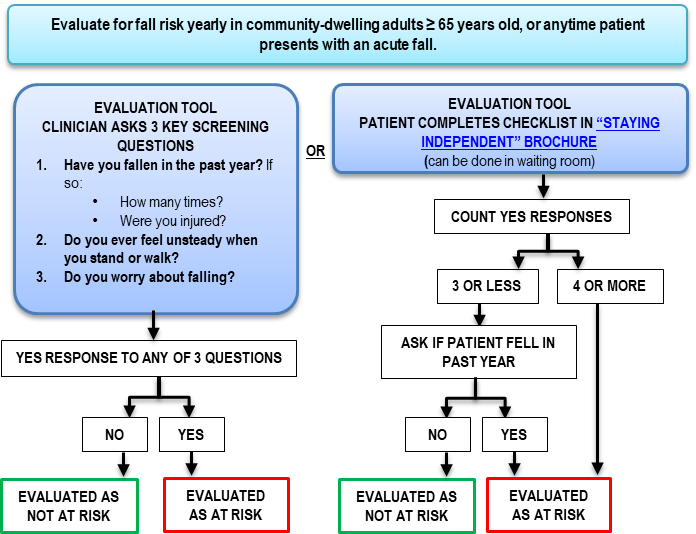Unknown Facts About Dementia Fall Risk
Unknown Facts About Dementia Fall Risk
Blog Article
5 Easy Facts About Dementia Fall Risk Described
Table of ContentsSee This Report about Dementia Fall RiskWhat Does Dementia Fall Risk Mean?Dementia Fall Risk Can Be Fun For AnyoneNot known Facts About Dementia Fall Risk
A fall risk evaluation checks to see exactly how likely it is that you will certainly drop. The analysis normally includes: This consists of a series of questions concerning your overall wellness and if you've had previous falls or troubles with balance, standing, and/or strolling.STEADI consists of screening, evaluating, and treatment. Interventions are suggestions that may minimize your risk of dropping. STEADI includes 3 steps: you for your threat of falling for your danger elements that can be boosted to attempt to avoid falls (as an example, equilibrium troubles, impaired vision) to reduce your threat of falling by making use of reliable approaches (for example, giving education and resources), you may be asked numerous questions consisting of: Have you fallen in the past year? Do you really feel unstable when standing or walking? Are you fretted about falling?, your service provider will certainly test your stamina, equilibrium, and stride, making use of the complying with fall evaluation devices: This examination checks your gait.
Then you'll rest down once more. Your copyright will check how much time it takes you to do this. If it takes you 12 seconds or more, it might suggest you are at greater danger for a loss. This examination checks stamina and equilibrium. You'll rest in a chair with your arms crossed over your chest.
Move one foot halfway onward, so the instep is touching the big toe of your various other foot. Relocate one foot fully in front of the other, so the toes are touching the heel of your other foot.
The Main Principles Of Dementia Fall Risk
Most drops occur as an outcome of several adding elements; consequently, taking care of the threat of dropping begins with determining the elements that add to drop threat - Dementia Fall Risk. Some of the most pertinent threat factors include: Background of prior fallsChronic clinical conditionsAcute illnessImpaired stride and balance, reduced extremity weaknessCognitive impairmentChanges in visionCertain risky medicines and polypharmacyEnvironmental aspects can also raise the risk for drops, consisting of: Insufficient lightingUneven or damaged flooringWet or unsafe floorsMissing or harmed hand rails and order barsDamaged or improperly equipped tools, such as beds, wheelchairs, or walkersImproper use assistive devicesInadequate guidance of individuals staying in the NF, including those that display hostile behaviorsA successful fall threat monitoring program needs a thorough clinical analysis, with input from all members of the interdisciplinary team

The care plan must also consist of treatments that go to this site are system-based, such as those that advertise a safe environment (appropriate lights, hand rails, get hold of bars, etc). The effectiveness of the treatments must be reviewed occasionally, and the care plan changed as necessary to mirror adjustments in the autumn danger analysis. Implementing a fall danger administration system using evidence-based best technique can minimize the prevalence of drops in the NF, while limiting the potential for fall-related injuries.
The Single Strategy To Use For Dementia Fall Risk
The AGS/BGS guideline suggests screening all adults aged 65 years and older for autumn threat every year. This testing includes asking individuals whether they have actually fallen 2 or more times in the past year or looked for medical focus for a fall, or, if they have not dropped, whether they really feel unsteady when walking.
Individuals who have actually fallen when without injury needs to have their balance and gait reviewed; those with gait or balance irregularities need to obtain additional evaluation. A background of 1 loss without injury and without stride or balance issues does not necessitate further evaluation past ongoing yearly fall danger screening. Dementia Fall Risk. An autumn threat assessment is needed as component of the Welcome to Medicare exam

The 8-Second Trick For Dementia Fall Risk
Documenting a falls history is among the high quality indications for autumn avoidance and management. visit this web-site A crucial part of threat analysis is a medicine testimonial. Several courses of drugs raise loss threat (Table 2). copyright drugs in specific are independent predictors of drops. These medicines tend to be sedating, modify the sensorium, and harm balance and gait.
Postural hypotension can commonly be reduced by lowering the dose of blood pressurelowering drugs and/or quiting drugs that have orthostatic hypotension as a side impact. Use above-the-knee assistance pipe and sleeping with the head of the bed raised might likewise minimize postural decreases in high blood pressure. The recommended aspects of a fall-focused health examination are displayed in Box 1.

A TUG time more than or equivalent to 12 secs recommends high autumn risk. The 30-Second Chair Stand examination evaluates reduced extremity stamina and balance. Being incapable to stand from a chair of knee height without making use of one's arms shows raised loss risk. The 4-Stage Equilibrium test assesses static balance by having the person stand in 4 settings, each progressively extra tough.
Report this page